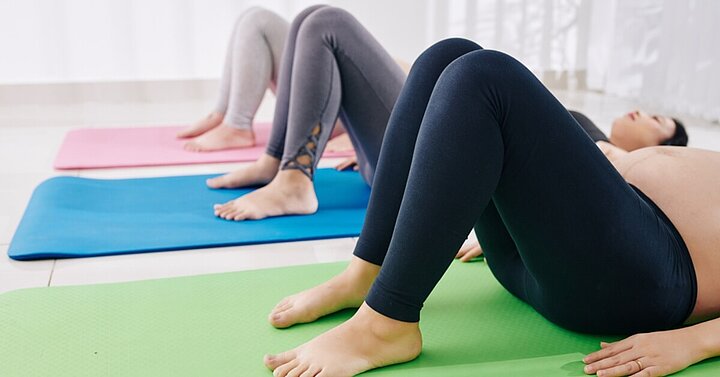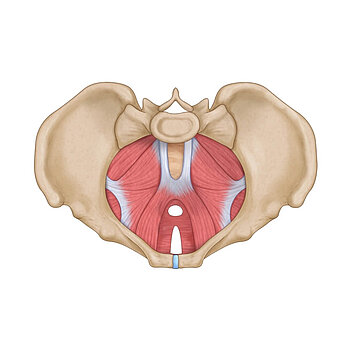Pelvic floor exercises
Postpartum | Wellbeing | Pregnancy | | Aby Tobin
Pregnancy may be the first time you have ever been aware of your pelvic floor. The truth is, it’s always been there, you’ve just given it a lot more to do.
What is the pelvic floor and why is it so important?
The pelvic floor is a group of muscles that sit like a bowl in your pelvis. The purpose of these muscles is to support your pelvic organs from beneath, keep you in control of your bladder and bowels, and they also play an important role in sexual pleasure.
The reason these muscles become especially important in pregnancy is because your pelvic floor is having to work harder than ever before. Your uterus, complete with placenta, amniotic fluid and baby, is heavy!
How to know if you have a weak pelvic floor
A weak pelvic floor can present in two main ways: it’s either lazy or it’s super tight. A lazy pelvic floor will be a thin muscle with no oomph. This means the muscle doesn’t have the strength to give any support or control. You may find you have to rush to the toilet multiple times a day, or you leak when you sneeze. Or maybe you start getting a heavy, dragging sensation down below at the end of the day.
A super tight pelvic floor will be a thick rigid muscle, trying so hard to keep up, but without the strength to do it. Telling signs can be constipation, or feeling like you aren’t fully emptying after going for a wee or a poo. You may be getting pelvic or low back pain because of the constant tension in the muscle.
What can I do about it?
The aim is to get trampoline-like pelvic floor muscles, that are as strong as The Rock’s biceps but as flexible as a salsa dancer’s hips. To achieve this, we need to do pelvic floor exercises – a specific form of muscle training.
- The benefits of doing this whilst pregnant or postnatally are huge.
- It reduces your risk of pelvic floor dysfunction, particularly urinary incontinence.
- It brings blood flow to the area, speeding up healing of any perineal birth injuries.
- It reduces your risk of developing or worsening a prolapse.
- And, it can even improve sexual pleasure (when you find the time and energy make it count!)
If you are already struggling with any of the symptoms described above then you should try to see a Pelvic Health Physiotherapist. You can find your nearest here

Pelvic floor exercises you can do at home
I teach pelvic floor muscle training in four steps:
- Awareness – You can’t control your muscles if you don’t know where they are. Start with some deep breaths, directing your inhale to the base of your ribs. If you think you may have any tightness in your pelvic floor muscles this is your key technique to relaxing the muscles off. Then we need to feel the pelvic floor muscles moving. If you’ve done any strengthening exercises, you’ll know that we breathe in to prepare and exhale on effort. In this case, imagine you are preparing to pick up a blueberry with your vagina – a fine image! Breathe in to prepare, and squeeze your muscles as you breathe out. You should be able to feel movement through your vaginal and rectal muscles.
- Control – Once you have some basic awareness, we then work on controlling a full lift, then a full release, often called a Kegel exercise. Practice lifting and letting go 10 times. If this makes any symptoms worse, then stop; focus on deep breathing and seek assessment from a professional.
- Strength – We are now going to start strengthening your pelvic floor muscles by holding that lift, developing some Mo Farah-like endurance. The key detail is that we do not hold our breath and we fully release after each hold. We also need the muscle to respond quickly when we sneeze for example, for this we are looking for Usain Bolt speed with a quick lift and release. So, a session might look like 10 holds, starting with a few seconds building up to 10 seconds, followed by 10 fast reps. Doing this once a day is fab; however, if you are experiencing any symptoms then aim for three times a day. It is easier if you pair it with other activities like having a cup of tea or brushing your teeth to help you remember. There are also apps you can purchase if you’d like reminders on your phone and more structure to your pelvic floor sessions.
- Function – the final step is to use the muscle in whole body movement. For this we start adding the pelvic floor into squats and lunges. This helps prepare the muscles to actually work when you need them day-to-day.
Do the pelvic floor training gadgets work?
There are lots of pelvic floor training gadgets on the market. Some are designed to give real-time feedback on what your pelvic floor muscle is doing; others work the muscles with electrical stimulation. I can’t tell you whether gadgets are ‘good’ or ‘bad’, because it depends on what your body needs. What I would say is that for the vast majority they aren’t necessary, but they can be an added help for the right person. Always speak to your midwife/medical team if you are considering using during pregnancy, and ideally seek assessment from a Pelvic Health specialist postnatally.
I hope this has given you some confidence and taken the mystery out of the pelvic floor. It is just muscle and can be trained like any other part of the body when you know how. Good luck!


